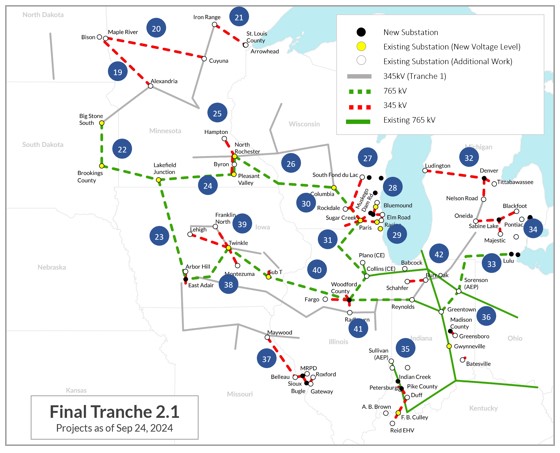by Priti Patel, GRE vice president and chief transmission officer
We all know that utilities and electric cooperatives are moving away from fossil fuels toward more renewable energy. At the same time, we are in the midst of transforming the electric grid in the Midwest region to assure electricity can be reliably transported from where it is produced to where it is needed. The utilities and cooperatives who own high voltage transmission lines in the Upper Midwest region are currently developing approximately $10 billion worth of transmission line projects to bolster the electric grid and ensure continued reliability into the future. This first set of projects approved in July 2022 by the region’s grid operator, MISO, was essentially low-hanging fruit. These were “no regrets” projects needed for reliability as our power supply evolves.
A second set of projects – this time worth $21-27 billion – is expected to be approved by MISO by the end of 2024. This portfolio, which is not final, but is in its “near-final” stages, currently consists of several 345-kilovolt (kV) and 765-kV transmission lines in Minnesota, essentially creating a new 765-kV backbone for the MISO region to support the evolution of the system. The 765-kV lines would work in conjunction with the other power lines to move power from generators across the Midwest to be used in each of our local communities.
Depending on how much attention you pay to power lines, you may realize that a 765-kV transmission line would be something new for Minnesota. Great River Energy, wholesale electric provider to [co-op name], certainly believes the timing is right for this as there are important benefits to 765-kV transmission. This is tried and true technology that is used in other parts of the country and the world. Great River Energy has been working closely with MISO through their planning process to advocate for the transmission projects that are in the best interest of its member-owner cooperatives. The Minnesota electric grid has reached a point where there is so much change required that a different approach is needed to maintain the reliability of the grid in a manner which is most affordable and least impactful. Much like the situation in the 1960s when the federal highway system was first developed, Minnesota needs a new transmission superhighway for power to flow through Minnesota and the broader Midwest region.
One of the most important benefits of 765-kV transmission is the efficiency of land use, which is critical to cooperative members who host so much electric infrastructure on their property. Just one 765-kV transmission line can take the place of six single-circuit 345-kV transmission lines, which means there would be much less land and public impact to move the same necessary amounts of power.
The map shown right is this “near-final” map of this second set of projects that MISO released earlier this summer. Although there could still be changes to the portfolio before it is approved at the end of the year, we aren’t expecting many more changes and we want to share with our cooperative communities the first glance at the general areas where some new transmission may be developed in the coming years. All projects in the portfolio will require regulatory permits and will go through a rigorous routing and siting process where public input will be deeply valued. Depending on what is finalized, Great River Energy may be involved in one or more of these projects.
Like the initial stretches of the federal highway system, the likely 765-kV transmission is a big step for Minnesota, but one which sets up Minnesota’s grid for generations to come. Creating this superhighway will ensure that Minnesotans have continued access to affordable, reliable and carbon-free generation.
Final Tranche 2.1 (Courtesy of MISO)

